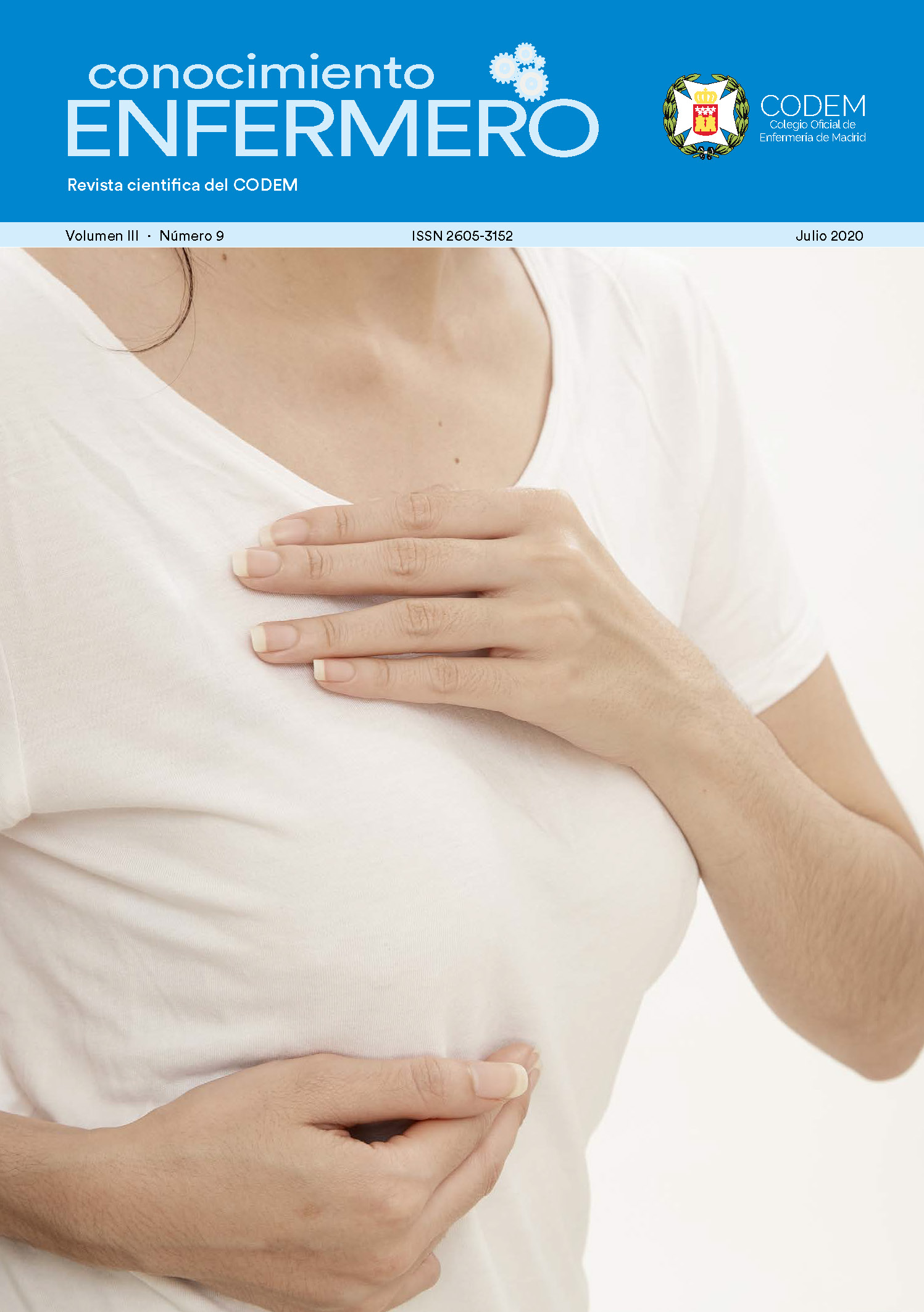Biological risks in nursing students at the San Jorge university
DOI:
https://doi.org/10.60108/ce.119Keywords:
occupational accidents; nursing students; transversal studyAbstract
Introduction. In Spain, during 2016, there were 555.722 accidents at work. Within the health sector, nursing professionals are exposed to a large number of occupational risks. Nursing students are also exposed to these risks on a daily basis during their clinical practices. The actions that present the greatest risk for this group are re-encapsulation of needles, opening ampoules of medication and preparing the medication for patients. The objective of this study is to know the experience and opinion of the students of the nursing degree of the San Jorge University on this topic.
Design. Descriptive and cross-sectional study carried out with first, second and third year students of the nursing degree at the Universidad San Jorge. Absolute or relative frequencies were calculated in percentage mode.
Results. Reencapsulation of needles was considered the most risky technique for an accident, followed by the preparation of medication. More than half of the participants consider that the emergency service is the most favorable to suffer an accident. The main reason that respondents consider that nursing students do not report biological accidents suffered, is the fear of stigmatization.
Conclusions. It is considered necessary to offer adequate training and information on biological accidents, from the university or the internship service to which the student has been assigned, transmitting tranquility and avoiding any type of repercussion or repression if he suffers an event of these characteristics.
References
Ministerio de Empleo y Seguridad Social [sede Web]. Estadística de Accidentes de Trabajo. Año 2013. Madrid: Gobierno de España; 2014 [acceso 5 de marzo de 2017]. Disponible en: http://www.empleo.gob.es/estadisticas/eat/welcome.htm.
Tomasina F, Gómez Etchebarne. Accidentes laborales en el Hospital de Clínicas. Rev Med Uruguay. 2001;17:156-160.
Palucci Marziale MH. Ocurrencia de accidentes de trabajo causados por material corto-punzante entre trabajadores de enfermería en hospitales de la región nordeste de Sao Paulo, Brasil. Ciencia y Enfermería. 2003;9(1): 21-30.
Clemente Yélamos M, Guzmán Vera CK, Martínez Vidal M, Álvarez Castillo MC, Sagües Cifuentes MJ. Accidentes percutáneos con riesgo biológico, producidos por dispositivos de seguridad en la Comunidad de Madrid. Med Segur Trab. 2012;58(227): 82-97.
Canli Ozer Z, Aydin Bektas H. Needlestick injuries during education period in nursing students in Turkey. Procedia Soc Behav Sci. 2012;46: 3798-801.
Cheung K, Ho SC, Ching SS, Chang KK. Analysis of needlestick injuries among nursing students in Hong Kong. Accid Anal Prev. 2010;42(6): 1744-50.
Center for disease control and prevention. Blood and body fluid exposure management. Atlanta: CDC;2016.
Souza Borges FR, Ribeiro LA, Oliveira LC. Occupational exposures to body fluids and behaviors regarding their prevention and post-exposure among medical and nursing students at a Brazilian public university. Rev Inst Med Trop Sao Paulo. 2014;56(2): 157-63.
Kasatpibal N, Whitney JD, Katechanok S, Ngamsakulrat S, Malairungsakul B, Sirikulsathean P, et al. Practices and impacts post-exposure to blood and body fluid in operating room nurses: A cross-sectional study. Int J Nurs Stud. 2016;57: 39-47.
Wang H, Fennie K, He G, Burgess J, Williams AB. A training programme for prevention of occupational exposure to bloodborne pathogens: impact on knowledge, behaviour and incidence of needle stick injuries among student nurses in Changsha, People’s Republic of China. J Adv Nurs. 2003;41(2): 187-94.
Fica A, Jemenao I, Ruiz G, Larrondo M, Hurtado C, Muñoz G, et al. Accidentes de riesgo biológico entre estudiantes de carreras de la salud. Cinco años de experiencia. Rev Chil Infect. 2010;27(1): 34-9.
Ortiz Molina S. Riesgos biológicos de los estudiantes de enfermería. Enferm Clin. 2003;13(5): 285-9.
Merino de la Hoz F, Durá Rox MJ, Rodríguez Martín E, González Gómez S, López López LM, Abajas Bustillo R, et al. Conocimiento y cumplimiento de las medidas de bioseguridad y accidentes biológicos de los estudiantes de enfermería en las prácticas clínicas. Enferm Clin.2010;20(3): 179-85.
Scaggiante R, Chemello L, Rinaldi R, Bartolucci GB, Trevisan A. Acute hepatitis C virus infection in a nurse trainee following a needlestick injury. World J Gastroenterol. 2013;19(4): 581-5.
García Gómez MM. Estudio de caracterización de accidentes biológicos en estudiantes de pregrado de la Facultad de Ciencias de la Salud. Universidad Libre. Seccional Cali. Enfermería Global. 2013;42: 199-214.
Rodriguez Martín A, Novalbos Ruiz JP, Costa Alonso MJ, Zafra Mezcua JA. Accidentalidad e incidencia de accidentes biológicos de riesgo en estudiantes de enfermería. Med Clin. 2000;115: 251-3.
Lozano Camilo E, González Aylinn G, Cadena LP. Caracterización de los accidentes por exposición a agente biológico en una población de estudiantes de medicina de Bucaramanga. Infect. 2012;16(4): 204-10.
Yao WX, Yang B, Yao C, Bai PS, Qian YR, Huang CH, et al. Needlestick injuries among nursing students in China. Nurse Educ Today. 2010;30(5): 435-7.
Kessler CS, McGuinn M, Spec A, Christensen J, Baragi R, Hershow RC. Underreporting of blood and body fluid exposures among health care students and trainees in the acute care setting: a 2007 survey. Am J Infect Control. 2011;39(2): 129-34.
Petrucci C, Alvaro R, Cicolini G, Cerone MP, Lancia L. Percutaneous and mucocutaneous exposures in nursing students: an italian observational study. J Nurs Scholarsh. 2016;41: 337-43.
Additional Files
Published
Issue
Section
License
En caso de que el artículo sea publicado, los autores aceptan transferir todos los derechos del trabajo presentado, incluidos los derechos de autor y aquellos relativos a la transmisión electrónica, exclusivamente a CODEM, de manera universal, en todos los idiomas, una vez que el trabajo haya sido aceptado para su publicación dentro de la revista electrónica CONOCIMIENTO ENFERMERO.
El autor podrá hacer copias ilimitadas del trabajo para uso docente, reutilizarlo en su totalidad o parcialmente en un libro escrito por el autor o hacer copias para su distribución en la institución en la que trabaja. CODEM hará mención al nombre del autor en las publicaciones que se realicen del trabajo.


